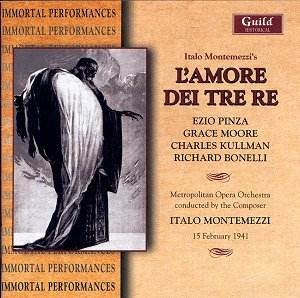Montemezzi’s L’Amore dei Tre Re (Not to be confused
with Prokofiev’s l’Amour de Trois Oranges which was current at
about the same time) was at one time a staple at the Met, but has fallen
completely out of the repertoire since this recording was made. The
story is in the gruesome verismo style. Blind king Archibaldo suspects
his daughter in law Fiora of meeting a lover Avito (who was her betrothed
before Archibaldo conquered her people and commanded her to marry his
son) while Manfredo, her husband and Archibaldo’s son, is away at war.
Archibaldo surprises the lovers in flagrante, the lover flees,
Fiora is defiant, and he strangles her. In the final act Fiora’s body
is resting in state but, unbeknownst to anyone, Archibaldo has put poison
on Fiora’s lips, expecting her lover to show up and give her one final
kiss. The trap works, but also catches Fiora’s husband Manfredo, and
the curtain falls on the usual pile of dead bodies.
The opera premiered in 1913 in Italy to indifferent
notices; but when Toscanini took it up in 1918 and thereafter championed
it, the work enjoyed some success in Europe and America over the next
years. Milton Cross in his radio foreword mentions that the work is
‘securely in the Met repertoire’ but in fact this 1941 broadcast performance
was nearly the last one. Eight years later the opera was revived once,
and then fell out of the repertoire. The score is intriguing now and
then but derivative, and can anyone be sympathetic for the character
of an enraged Italian king who strangles his daughter in law on stage?
For me the greatest interest here was Charles Kullman whose magnificent
voice triumphs over whatever he sings. When he has great music to sing,
as he did in 1936 in Vienna with Bruno Walter, the result is legendary.
The restorer Richard Caniel is very eloquent in his
praise of this opera which he considers to be one of the great operatic
masterpieces of all time and of Pinza’s performance, and indeed his
singing overall. Caniel doesn’t care for Grace Moore in general, but
suggests that in this case her usual inflexible tone is symmetrical
with the hard character of Fiora.
The restored sound is quite good throughout, with clear,
undistorted voices, little stage noise clutter, no crackle or scratch,
and relatively little congestion at the orchestral climaxes, but still
this is not a hi-fi recording. During this period broadcast and recording
engineers tended to turn the gain up and down capriciously and in restoration
an effort has been made to repair this.
Arthur Honegger specifically denied any connection
between the title of this opera (or the Christmas story) and the subtitle
of his Fifth Symphony, ‘Di tre re,’ written in 1950, but that has not
stopped speculation.
This recording has also been reviewed on Musicweb by
Robert J. Farr.
Paul Shoemaker
See also review
by Robert Farr


